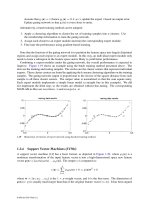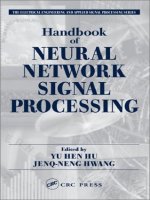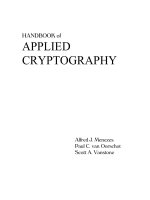li, jain - handbook of face recognition
Bạn đang xem bản rút gọn của tài liệu. Xem và tải ngay bản đầy đủ của tài liệu tại đây (23.82 MB, 716 trang )
Handbook of Face Recognition
Stan Z. Li
Anil K. Jain
Editors
Handbook of
Face Recognition
Second Edition
Editors
Stan Z. Li
Institute of Automation, Center Biometrics
Research & Security
Chinese Academy of Science
Room 1227, No. 95 Zhongguancun East Rd
Beijing 100190
People’s Republic of China
Anil K. Jain
Dept. Computer Science & Engineering
Michigan State University
East Lansing, MI 48824-1226
USA
ISBN 978-0-85729-931-4 e-ISBN 978-0-85729-932-1
DOI 10.1007/978-0-85729-932-1
Springer London Dordrecht Heidelberg New York
British Library Cataloguing in Publication Data
A catalogue record for this book is available from the British Library
Library of Congress Control Number: 2011936022
© Springer-Verlag London Limited 2011
Apart from any fair dealing for the purposes of research or private study, or criticism or review, as per-
mitted under the Copyright, Designs and Patents Act 1988, this publication may only be reproduced,
stored or transmitted, in any form or by any means, with the prior permission in writing of the publish-
ers, or in the case of reprographic reproduction in accordance with the terms of licenses issued by the
Copyright Licensing Agency. Enquiries concerning reproduction outside those terms should be sent to
the publishers.
The use of registered names, trademarks, etc., in this publication does not imply, even in the absence of a
specific statement, that such names are exempt from the relevant laws and regulations and therefore free
for general use.
The publisher makes no representation, express or implied, with regard to the accuracy of the information
contained in this book and cannot accept any legal responsibility or liability for any errors or omissions
that may be made.
Cover design: VTeX UAB, Lithuania
Printed on acid-free paper
Springer is part of Springer Science+Business Media (www.springer.com)
Preface
Face recognition is one of the most important abilities that we use in our daily lives.
There are several reasons for the growing interest in automated face recognition,
including rising concerns for public security, the need for identity verification for
physical and logical access, and the need for face analysis and modeling techniques
in multimedia data management and digital entertainment. Research in automatic
face recognition started in the 1960s. Recent years have seen significant progress
in this area and a number of face recognition and modeling systems have been de-
veloped and deployed. However, accurate and robust face recognition still offers a
number of challenges to computer vision and pattern recognition researchers, espe-
cially under unconstrained environments.
This book is written with two primary motivations. The first is to compile major
approaches, algorithms, and technologies available for automated face recognition.
The second is to provide a reference book to students, researchers, and practitioners.
The book is intended for anyone who plans to work in face recognition or who
wants to become familiar with the state-of-the-art in face recognition. It also pro-
vides references for scientists and engineers working in image processing, computer
vision, biometrics and security, computer graphics, animation, and the computer
game industry. The material contained in the book fits the following categories: ad-
vanced tutorial, state-of-the-art survey, and a guide to current technology.
This second edition consists of twenty seven chapters, with additions and up-
dates from the sixteen chapters in the first edition. It covers all the subareas and
major components necessary for developing face recognition algorithms, designing
operational systems, and addressing related issues in large scale applications. Each
chapter focuses on a specific topic or system component, introduces background in-
formation, reviews up-to-date techniques, presents results, and points out challenges
and future directions.
The twenty seven chapters are divided into four parts according to the main prob-
lems addressed. Part I, Face Image Modeling and Representation, consists of ten
chapters, presenting theories in face image modeling and facial feature representa-
tion. Part II, Face Recognition Techniques, also consists of ten chapters, presenting
techniques for face detection, landmark detection, and face recognition in static face
v
vi Preface
images, in video, in non-visible spectrum images, and in 3D. Part III, Performance
Evaluation: Machines and Humans, consists of three chapters, presenting methods
and programs for face recognition evaluation and also studies and comparisons with
human performance. Part IV, Face Recognition Applications, consists of four chap-
ters, presenting various applications of face recognition and related issues.
A project like this requires the efforts and support of many individuals and or-
ganizations. First of all, we would like to thank all the authors for their outstanding
contributions which made this edition possible. We also thank Wayne Wheeler and
Simon Rees, the Springer editors for their support and patience during the course
of this project. Thanks are also due to a number of individuals who have assisted us
during the editing phase of this project, including Shikun Feng, Shengcai Liao, Xi-
angsheng Huang, Brendan Klare, Unsang Park, Abhishek Nagar, and not the least
Kim Thompson for her careful proofreading of the manuscript. Stan Z. Li would
like to acknowledge the support of the Chinese National Natural Science Foun-
dation Project #61070146, the National Science and Technology Support Program
Project #2009BAK43B26, the AuthenMetric R&D Funds, and the TABULA RASA
project () under the Seventh Framework Pro-
gramme for research and technological development (FP7) of the European Union
(EU), grant agreement #257289. Anil Jain’s research was partially supported by
the WCU (World Class University) program funded by the Ministry of Education,
Science and Technology through the National Research Foundation of Korea (R31-
10008) to the Brain & Cognitive Engineering Department, Korea University where
he is an Adjunct Professor.
Stan Z. Li
Anil K. Jain
Beijing, People’s Republic of China
East Lansing, USA
Contents
1 Introduction 1
Stan Z. Li and Anil K. Jain
Part I Face Image Modeling and Representation
2 Face Recognition in Subspaces 19
Gregory Shakhnarovich and Baback Moghaddam
3 Face Subspace Learning 51
Wei Bian and Dacheng Tao
4 Local Representation of Facial Features 79
Joni-Kristian Kämäräinen, Abdenour Hadid, and Matti Pietikäinen
5 Face Alignment Models 109
Phil Tresadern, Tim Cootes, Chris Taylor, and Vladimir Petrovi
´
c
6 Morphable Models of Faces 137
Reinhard Knothe, Brian Amberg, Sami Romdhani, Volker Blanz, and
Thomas Vetter
7 Illumination Modeling for Face Recognition 169
Ronen Basri and David Jacobs
8 Face Recognition Across Pose and Illumination 197
Ralph Gross, Simon Baker, Iain Matthews, and Takeo Kanade
9 Skin Color in Face Analysis 223
J. Birgitta Martinkauppi, Abdenour Hadid, and Matti Pietikäinen
10 Face Aging Modeling 251
Unsang Park and Anil K. Jain
vii
viii Contents
Part II Face Recognition Techniques
11 Face Detection 277
Stan Z. Li and Jianxin Wu
12 Facial Landmark Localization 305
Xiaoqing Ding and Liting Wang
13 Face Tracking and Recognition in Video 323
Rama Chellappa, Ming Du, Pavan Turaga, and Shaohua Kevin Zhou
14 Face Recognition at a Distance 353
Frederick W. Wheeler, Xiaoming Liu, and Peter H. Tu
15 Face Recognition Using Near Infrared Images 383
Stan Z. Li and Dong Yi
16 Multispectral Face Imaging and Analysis 401
Andreas Koschan, Yi Yao, Hong Chang, and Mongi Abidi
17 Face Recognition Using 3D Images 429
I.A. Kakadiaris, G. Passalis, G. Toderici, E. Efraty, P. Perakis, D. Chu,
S. Shah, and T. Theoharis
18 Facial Action Tracking 461
Jörgen Ahlberg and Igor S. Pandzic
19 Facial Expression Recognition 487
Yingli Tian, Takeo Kanade, and Jeffrey F. Cohn
20 Face Synthesis 521
Yang Wang, Zicheng Liu, and Baining Guo
Part III Performance Evaluation: Machines and Humans
21 Evaluation Methods in Face Recognition 551
P. Jonathon Phillips, Patrick Grother, and Ross Micheals
22 Dynamic Aspects of Face Processing in Humans 575
Heinrich H. Bülthoff, Douglas W. Cunningham, and Christian Wallraven
23 Face Recognition by Humans and Machines 597
Alice J. O’Toole
Part IV Face Recognition Applications
24 Face Recognition Applications 617
Thomas Huang, Ziyou Xiong, and Zhenqiu Zhang
25 Large Scale Database Search 639
Michael Brauckmann and Christoph Busch
Contents ix
26 Face Recognition in Forensic Science 655
Nicole A. Spaun
27 Privacy Protection and Face Recognition 671
Andrew W. Senior and Sharathchandra Pankanti
Index 693
Mongi Abidi Imaging, Robotics, and Intelligent Systems Lab, University of Ten-
nessee, Knoxville, TN 37996, USA,
Jörgen Ahlberg Division of Information Systems, Swedish Defence Research
Agency (FOI), P.O. Box 1165, 583 34 Linköping, Sweden,
Brian Amberg Department of Mathematics and Computer Science, University of
Basel, Bernoullistrasse 16, 4056 Basel, Switzerland,
Heinrich H. Bülthoff Max Planck Institute for Biological Cybernetics, Spe-
mannstrasse 38, 72076 Tübingen, Germany, ;
Department of Brain and Cognitive Engineering, Korea University, Seoul, Korea
Simon Baker Robotics Institute, Carnegie Mellon University, Pittsburgh, PA 15213,
USA,
Ronen Basri The Weizmann Institute of Science, Rehovot 76100, Israel,
Wei Bian Centre for Quantum Computation & Intelligence Systems, FEIT, Univer-
sity of Technology, Sydney, NSW 2007, Australia,
Volker Blanz Universität Siegen, Hölderlinstrasse 3, 57068 Siegen, Germany,
Michael Brauckmann L-1 Identity Solutions AG, Bochum, Germany,
Christoph Busch Hochschule Darmstadt/Fraunhofer IGD, Darmstadt, Germany,
Hong Chang Imaging, Robotics, and Intelligent Systems Lab, University of Ten-
nessee, Knoxville, TN 37996, USA,
Rama Chellappa Department of Electrical and Computer Engineering, Center for
Automation Research, University of Maryland, College Park, MD 20742, USA,
xi
xii Contributors
D. Chu Computational Biomedicine Lab, Department of Computer Science, Uni-
versity of Houston, Houston, TX 77204, USA
Jeffrey F. Cohn Department of Psychology, University of Pittsburgh, Pittsburgh,
PA 15260, USA,
Tim Cootes Imaging Science and Biomedical Engineering, University of Manch-
ester, Manchester, UK,
Douglas W. Cunningham Max Planck Institute for Biological Cybernetics, Spe-
mannstrasse 38, 72076 Tübingen, Germany, ;
Brandenburg Technical University, 03046 Cottbus, Germany
Xiaoqing Ding State Key Laboratory of Intelligent Technology and Systems,
Tsinghua National Laboratory for Information Science and Technology, Depart-
ment of Electronic Engineering, Tsinghua University, Beijing 100084, China,
Ming Du Department of Electrical and Computer Engineering, Center for Au-
tomation Research, University of Maryland, College Park, MD 20742, USA,
E. Efraty Computational Biomedicine Lab, Department of Computer Science,
University of Houston, Houston, TX 77204, USA
Ralph Gross Robotics Institute, Carnegie Mellon University, Pittsburgh, PA 15213,
USA,
Patrick Grother National Institute of Standards and Technology, Gaithersburg,
MD 20899, USA,
Baining Guo Microsoft Research Asia, Beijing 100080, China,
Abdenour Hadid Machine Vision Group, Department of Electrical and Infor-
mation Engineering, University of Oulu, P.O. Box 4500, 90014 Oulu, Finland,
fi
Thomas Huang University of Illinois at Urbana-Champaign, Urbana, IL 61801,
USA,
David Jacobs University of Maryland, College Park, MD 20742, USA,
Anil K. Jain Michigan State University, East Lansing, MI 48824, USA,
I.A. Kakadiaris Computational Biomedicine Lab, Department of Computer Sci-
ence, University of Houston, Houston, TX 77204, USA,
Takeo Kanade Robotics Institute, Carnegie Mellon University, Pittsburgh, PA
15213, USA,
Contributors xiii
Reinhard Knothe Department of Mathematics and Computer Science, University
of Basel, Bernoullistrasse 16, 4056 Basel, Switzerland,
Andreas Koschan Imaging, Robotics, and Intelligent Systems Lab, University of
Tennessee, Knoxville, TN 37996, USA,
Joni-Kristian Kämäräinen Machine Vision and Pattern Recognition Laboratory,
Lappeenranta University of Technology, Lappeenranta, Finland,
Joni.Kamarainen@lut.fi
Stan Z. Li Center for Biometrics and Security Research & National Laboratory of
Pattern Recognition, Institute of Automation, Chinese Academy of Sciences, Bei-
jing, China,
Xiaoming Liu Visualization and Computer Vision Lab, GE Global Research,
Niskayuna, NY 12309, USA,
Zicheng Liu Microsoft Research, Redmond, WA 98052, USA,
J. Birgitta Martinkauppi Department of Electrical Engineering and Automation,
University of Vaasa, Wolffintie 34, 65101 Vaasa, Finland, birmar@uwasa.fi
Iain Matthews Robotics Institute, Carnegie Mellon University, Pittsburgh, PA
15213, USA,
Ross Micheals National Institute of Standards and Technology, Gaithersburg,
MD 20899, USA,
Baback Moghaddam Mitsubishi Electric Research Labs, Cambridge, MA 02139,
USA,
Alice J. O’Toole School of Behavioral and Brain Sciences, The University of
Texas at Dallas, 800 W. Campbell Rd., Richardson, TX 75083-0688, USA,
Igor S. Pandzic Faculty of Electrical Engineering and Computing, University of
Zagreb, Unska 3, 10000 Zagreb, Croatia,
Sharathchandra Pankanti IBM Research, Yorktown Heights, NY 10598, USA,
Unsang Park Michigan State University, East Lansing, MI 48824, USA,
G. Passalis Computational Biomedicine Lab, Department of Computer Science,
University of Houston, Houston, TX 77204, USA; Computer Graphics Labora-
tory, Department of Informatics and Telecommunications, University of Athens,
Ilisia 15784, Greece
P. Perakis Computational Biomedicine Lab, Department of Computer Science,
University of Houston, Houston, TX 77204, USA; Computer Graphics Labora-
xiv Contributors
tory, Department of Informatics and Telecommunications, University of Athens,
Ilisia 15784, Greece
Vladimir Petrovi
´
c Imaging Science and Biomedical Engineering, University of
Manchester, Manchester, UK
P. Jonathon Phillips National Institute of Standards and Technology, Gaithersburg,
MD 20899, USA,
Matti Pietikäinen Machine Vision Group, Department of Electrical and Infor-
mation Engineering, University of Oulu, P.O. Box 4500, 90014 Oulu, Finland,
fi
Sami Romdhani Department of Mathematics and Computer Science, University
of Basel, Bernoullistrasse 16, 4056 Basel, Switzerland,
Andrew W. Senior Google Research, New York, NY 10011, USA,
S. Shah Computational Biomedicine Lab, Department of Computer Science, Uni-
versity of Houston, Houston, TX 77204, USA
Gregory Shakhnarovich Computer Science and Artificial Intelligence Laboratory,
MIT, Cambridge, MA 02139, USA,
Nicole A. Spaun Forensic Audio, Video and Image Analysis Unit, Federal Bureau
of Investigation, Quantico, VA, USA, ; United States
Army Europe Headquarters, Heidelberg, Germany; USAREUR, CMR 420, Box
2872, APO AE 09036, USA
Dacheng Tao Centre for Quantum Computation & Intelligence Systems, FEIT,
University of Technology, Sydney, NSW 2007, Australia,
Chris Taylor Imaging Science and Biomedical Engineering, University of Manch-
ester, Manchester, UK
T. Theoharis Computational Biomedicine Lab, Department of Computer Science,
University of Houston, Houston, TX 77204, USA; Computer Graphics Labora-
tory, Department of Informatics and Telecommunications, University of Athens,
Ilisia 15784, Greece
Yingli Tian Department of Electrical Engineering, The City College of New York,
New York, NY 10031, USA,
G. Toderici Computational Biomedicine Lab, Department of Computer Science,
University of Houston, Houston, TX 77204, USA
Phil Tresadern Imaging Science and Biomedical Engineering, University of
Manchester, Manchester, UK
Peter H. Tu Visualization and Computer Vision Lab, GE Global Research,
Niskayuna, NY 12309, USA,
Contributors xv
Pavan Turaga Department of Electrical and Computer Engineering, Center for
Automation Research, University of Maryland, College Park, MD 20742, USA,
Thomas Vetter Department of Mathematics and Computer Science, University of
Basel, Bernoullistrasse 16, 4056 Basel, Switzerland,
Christian Wallraven Max Planck Institute for Biological Cybernetics, Spe-
mannstrasse 38, 72076 Tübingen, Germany, ; Department
of Brain and Cognitive Engineering, Korea University, Seoul, Korea
Liting Wang State Key Laboratory of Intelligent Technology and Systems, Ts-
inghua National Laboratory for Information Science and Technology, Depart-
ment of Electronic Engineering, Tsinghua University, Beijing 100084, China,
Yang Wang Carnegie Mellon University, Pittsburgh, PA 15213, USA,
Frederick W. Wheeler Visualization and Computer Vision Lab, GE Global Re-
search, Niskayuna, NY 12309, USA,
Jianxin Wu School of Computer Engineering, Nanyang Technological University,
Singapore, Singapore,
Ziyou Xiong United Technologies Research Center, East Hartford, CT 06108,
USA,
Yi Yao Visualization and Computer Vision Lab, GE Global Research, Niskayuna,
NY 12309, USA,
Dong Yi Center for Biometrics and Security Research & National Laboratory of
Pattern Recognition, Institute of Automation, Chinese Academy of Sciences, Bei-
jing, China,
Zhenqiu Zhang University of Illinois at Urbana-Champaign, Urbana, IL 61801,
USA,
Shaohua Kevin Zhou Siemens Corporate Research, 755 College Road East,
Princeton, NJ 08540, USA,
Introduction
Stan Z. Li and Anil K. Jain
1.1 Face Recognition
Face recognition is a task that humans perform routinely and effortlessly in our daily
lives. Wide availability of powerful and low-cost desktop and embedded computing
systems has created an enormous interest in automatic processing of digital images
in a variety of applications, including biometric authentication, surveillance, human-
computer interaction, and multimedia management. Research and development in
automatic face recognition follows naturally.
Face recognition has several advantages over other biometric modalities such as
fingerprint and iris: besides being natural and nonintrusive, the most important ad-
vantage of face is that it can be captured at a distance and in a covert manner. Among
the six biometric attributes considered by Hietmeyer [16], facial features scored the
highest compatibility in a Machine Readable Travel Documents (MRTD) [27]sys-
tem based on a number of evaluation factors, such as enrollment, renewal, machine
requirements, and public perception, shown in Fig. 1.1. Face recognition, as one
of the major biometric technologies, has become increasingly important owing to
rapid advances in image capture devices (surveillance cameras, camera in mobile
phones), availability of huge amounts of face images on the Web, and increased
demands for higher security.
The first automated face recognition system was developed by Takeo Kanade
in his Ph.D. thesis work [18] in 1973. There was a dormant period in automatic
face recognition until the work by Sirovich and Kirby [19, 38] on a low dimen-
S.Z. Li (
)
Center for Biometrics and Security Research & National Laboratory of Pattern Recognition,
Institute of Automation, Chinese Academy of Sciences, Beijing, China
e-mail:
A.K. Jain
Michigan State University, East Lansing, MI 48824, USA
e-mail:
S.Z. Li, A.K. Jain (eds.), Handbook of Face Recognition,
DOI 10.1007/978-0-85729-932-1_1, © Springer-Verlag London Limited 2011
1
2 S.Z. Li and A.K. Jain
Fig. 1.1 A scenario of using biometric MRTD systems for passport control (left), and a compar-
ison of various biometric traits based on MRTD compatibility (right, from Hietmeyer [16]with
permission)
sional face representation, derived using the Karhunen–Loeve transform or Princi-
pal Component Analysis (PCA). It is the pioneering work of Turk and Pentland on
Eigenface [42] that reinvigorated face recognition research. Other major milestones
in face recognition include: the Fisherface method [3, 12], which applied Linear
Discriminant Analysis (LDA) after a PCA step to achieve higher accuracy; the use
of local filters such as Gabor jets [21, 45] to provide more effective facial features;
and the design of the AdaBoost learning based cascade classifier architecture for
real time face detection [44].
Face recognition technology is now significantly advanced since the time when
the Eigenface method was proposed. In the constrained situations, for example
where lighting, pose, stand-off, facial wear, and facial expression can be controlled,
automated face recognition can surpass human recognition performance, especially
when the database (gallery) contains a large number of faces.
1
However, automatic
face recognition still faces many challenges when face images are acquired under
unconstrained environments. In the following sections, we give a brief overview of
the face recognition process, analyze technical challenges, propose possible solu-
tions, and describe state-of-the-art performance.
This chapter provides an introduction to face recognition research. Main steps of
face recognition processing are described. Face detection and recognition problems
are explained from a face subspace viewpoint. Technology challenges are identified
and possible strategies for solving some of the problems are suggested.
1.2 Categorization
As a biometric system, a face recognition system operates in either or both of two
modes: (1) face verification (or authentication), and (2) face identification (or recog-
nition). Face verification involves a one-to-one match that compares a query face
1
Most individuals can identify only a few thousand people in real life.
1 Introduction 3
image against an enrollment face image whose identity is being claimed. Person
verification for self-serviced immigration clearance using E-passport is one typical
application.
Face identification involves one-to-many matching that compares a query face
against multiple faces in the enrollment database to associate the identity of the
query face to one of those in the database. In some identification applications, one
just needs to find the most similar face. In a watchlist check or face identification
in surveillance video, the requirement is more than finding most similar faces; a
confidence level threshold is specified and all those faces whose similarity score is
above the threshold are reported.
The performance of a face recognition system largely depends on a variety of
factors such as illumination, facial pose, expression, age span, hair, facial wear, and
motion. Based on these factors, face recognition applications may be divided into
two broad categories in terms of a user’s cooperation: (1) cooperative user scenarios
and (2) noncooperative user scenarios.
The cooperative case is encountered in applications such as computer login,
physical access control, and e-passport, where the user is willing to be coopera-
tive by presenting his/her face in a proper way (for example, in a frontal pose with
neutral expression and eyes open) in order to be granted the access or privilege.
In the noncooperative case, which is typical in surveillance applications, the user
is unaware of being identified. In terms of distance between the face and the camera,
near field face recognition (less than 1 m) for cooperative applications (e.g., access
control) is the least difficult problem, whereas far field noncooperative applications
(e.g., watchlist identification) in surveillance video is the most challenging.
Applications in-between the above two categories can also be foreseen. For ex-
ample, in face-based access control at a distance, the user is willing to be coopera-
tive but he is unable to present the face in a favorable condition with respect to the
camera. This may present challenges to the system even though such cases are still
easier than identifying the identity of the face of a subject who is not cooperative.
However, in almost all of the cases, ambient illumination is the foremost challenge
for most face recognition applications.
1.3 Processing Workflow
Face recognition is a visual pattern recognition problem, where the face, represented
as a three-dimensional object that is subject to varying illumination, pose, expres-
sion, and other factors, needs to be identified based on acquired images. While two-
dimensional face images are commonly used in most applications, certain applica-
tions requiring higher levels of security demand the use of three-dimensional (depth
or range) images or optical images beyond the visual spectrum. A face recognition
system generally consists of four modules as depicted in Fig. 1.2: face localiza-
tion, normalization, feature extraction, and matching. These modules are explained
below.
4 S.Z. Li and A.K. Jain
Fig. 1.2 Depiction of face recognition processing flow
Face detection segments the face area from the background. In the case of video,
the detected faces may need to be tracked across multiple frames using a face track-
ing component. While face detection provides a coarse estimate of the location and
scale of the face, face landmarking localizes facial landmarks (e.g., eyes, nose,
mouth, and facial outline). This may be accomplished by a landmarking module
or face alignment module.
Face normalization is performed to normalize the face geometrically and pho-
tometrically. This is necessary because state-of-the-art recognition methods are ex-
pected to recognize face images with varying pose and illumination. The geomet-
rical normalization process transforms the face into a standard frame by face crop-
ping. Warping or morphing may be used for more elaborate geometric normaliza-
tion. The photometric normalization process normalizes the face based on properties
such as illumination and gray scale.
Face feature extraction is performed on the normalized face to extract salient
information that is useful for distinguishing faces of different persons and is robust
with respect to the geometric and photometric variations. The extracted face features
are used for face matching.
In face matching the extracted features from the input face are matched against
one or many of the enrolled faces in the database. The matcher outputs ‘yes’ or
‘no’ for 1:1 verification; for 1:N identification, the output is the identity of the in-
put face when the top match is found with sufficient confidence or unknown when
the tip match score is below a threshold. The main challenge in this stage of face
recognition is to find a suitable similarity metric for comparing facial features.
The accuracy of face recognition systems highly depends on the features that are
extracted to represent the face which, in turn, depend on correct face localization and
normalization. While face recognition still remains a challenging pattern recognition
problem, it may be analyzed from the viewpoint of face subspaces or manifolds, as
follows.
1.4 Face Subspace
Although face recognition technology has significantly improved and can now be
successfully performed in “real-time” for images and videos captured under favor-
able (constrained) situations, face recognition is still a difficult endeavor, especially
1 Introduction 5
Fig. 1.3 Face subspace or manifolds. a Face versus nonface manifolds. b Face manifolds of dif-
ferent individuals
for unconstrained tasks where viewpoint, illumination, expression, occlusion, and
facial accessories can vary considerably. This can be illustrated from face subspace
or manifold viewpoint.
Subspace analysis techniques for face recognition are based on the fact that a
class of patterns of interest, such as the face, resides in a subspace of the input
image space. For example, a 64 × 64 8-bit image with 4096 pixels can express a
large number of pattern classes, such as trees, houses, and faces. However, among
the 256
4096
> 10
9864
possible “configurations,” only a tiny fraction correspond to
faces. Therefore, the pixel-based image representation is highly redundant, and the
dimensionality of this representation could be greatly reduced when only the face
patterns are of interest.
The eigenface or PCA method [19, 42] derives a small number (typically 40 or
lower) of principal components or eigenfaces from a set of training face images.
Given the eigenfaces as basis for a face subspace, a face image is compactly rep-
resented by a low dimensional feature vector and a face can be reconstructed as a
linear combination of the eigenfaces. The use of subspace modeling techniques has
significantly advanced the face recognition technology.
The manifold or distribution of all the faces accounts for variations in facial ap-
pearance whereas the nonface manifold accounts for all objects other than the faces.
If we examine these manifolds in the image space, we find them highly nonlinear
and nonconvex [5, 41]. Figure 1.3(a) illustrates face versus nonface manifolds and
Fig. 1.3(b) illustrates the manifolds of two individuals in the entire face manifold.
Face detection can be considered as a task of distinguishing between the face and
nonface manifolds in the image (subwindow) space and face recognition can be con-
sidered as a task of distinguishing between faces of different individuals in the face
manifold.
Figure 1.4 further demonstrates the nonlinearity and nonconvexity of face mani-
folds in a PCA subspace spanned by the first three principal components, where the
6 S.Z. Li and A.K. Jain
Fig. 1.4 Nonlinearity and nonconvexity of face manifolds under (from top to bottom) translation,
rotation, scaling, and Gamma transformations
plots are drawn from real face image data. Each plot depicts the manifolds of three
individuals (in three colors). The data consists of 64 frontal face images for each
1 Introduction 7
individual. A transform (horizontal transform, in-plane rotation, size scaling, and
gamma transform for the 4 groups, respectively) is performed on each face image
with 11 gradually varying parameters, producing 11 transformed face images; each
transformed image is cropped to contain only the face region; the 11 cropped face
images form a sequence. A curve in this figure represents such a sequence in the
PCA space, and so there are 64 curves for each individual. The three-dimensional
(3D) PCA space is projected on three different 2D spaces (planes). We can observe
the nonlinearity of the trajectories.
The following observations can be drawn based on Fig. 1.4. First, while this
example is demonstrated in the PCA space, more complex (nonlinear and noncon-
vex) trajectories are expected in the original image space. Second, although these
face images have been subjected to geometric transformations in the 2D plane and
pointwise lighting (gamma) changes, more significant complexity of trajectories is
expected for geometric transformations in 3D space (for example, out-of-plane head
rotations) and ambient lights.
1.5 Technology Challenges
AsshowninFig.1.3, the problem of face detection is highly nonlinear and non-
convex, even more so for face matching. Face recognition evaluation reports, for
example Face Recognition Technology (FERET) [34], Face Recognition Vendor
Test (FRVT) [31] and other independent studies, indicate that the performance of
many state-of-the-art face recognition methods deteriorates with changes in light-
ing, pose, and other factors [8, 43, 50]. The key technical challenges in automatic
face recognition are summarized below.
Large Variability in Facial Appearance Whereas shape and reflectance are in-
trinsic properties of a face, the appearance (i.e., the texture) of a face is also influ-
enced by several other factors, including the facial pose (or, equivalently, camera
viewpoint), illumination, and facial expression. Figure 1.5 shows an example of
large intra-subject variations caused by these factors. Aging is also an important
factor that leads to an increase in the intra-subject variations especially in applica-
tions requiring duplication of government issued photo ID documents (e.g., driver
licenses and passports). In addition to these, various imaging parameters, such as
aperture, exposure time, lens aberrations, and sensor spectral response also increase
intra-subject variations. Face-based person identification is further complicated by
possible small inter-subject variations (Fig. 1.6). All these factors are confounded
in the image data, so “the variations between the images of the same face due to il-
lumination and viewing direction are almost always larger than the image variation
due to change in face identity” [30]. This variability makes it difficult to extract the
intrinsic information about the face identity from a facial image.
Complex Nonlinear Manifolds As illustrated above, the entire face manifold
is highly nonconvex, and so is the face manifold of any individual under various
8 S.Z. Li and A.K. Jain
Fig. 1.5 Intra-subject variations in pose, illumination, expression, occlusion, accessories (e.g.,
glasses), color, and brightness. (Courtesy of Rein-Lien Hsu [17])
Fig. 1.6 Similarity of frontal faces between a twins (downloaded from www.marykateandashley.
com); and b a father and his son (downloaded from BBC news, news.bbc.co.uk)
changes. Linear methods such as PCA [19, 42], independent component analysis
(ICA) [2], and linear discriminant analysis (LDA) [3]) project the data linearly from
a high-dimensional space (for example, the image space) to a low-dimensional sub-
space. As such, they are unable to preserve the nonconvex variations of face man-
ifolds necessary to differentiate among individuals. In a linear subspace, Euclidean
distance and, more generally, the Mahalanobis distance do not perform well for dis-
criminating between face and nonface manifolds and between manifolds of differ-
ent individuals (Fig. 1.7(a)). This limits the power of the linear methods to achieve
highly accurate face detection and recognition in many practical scenarios.
High Dimensionality and Small Sample Size Another challenge in face recogni-
tion is the generalization ability, which is illustrated in Fig. 1.7(b). The figure depicts
a canonical face image of size 112 ×92 which resides in a 10,304-dimensional fea-
ture space. The number of example face images per person (typically fewer than 10,
and sometimes just one) available for learning the manifold is usually much smaller









